Australia, Art and architecture of. Australia’s unique combination of landscape, peoples, and cultural influences has produced art and architecture that are both rich and varied. The arts in Australia have been influenced by a wide range of factors, both from within Australia and from overseas. The first people who lived in Australia were creating paintings, carvings, and other works of art long before Europeans arrived. Great Britain (later the United Kingdom) settled Australia as a prison colony in 1788. As a result of British settlement, European styles of art heavily influenced Australian artists in the 1800’s and early 1900’s. Increasingly since the 1960’s, Asian art has become particularly influential.
However, it is misleading to view Australian art only in terms of outside influences. Many complex internal social and historical forces have played an important role in the history of Australian art. Since 1788, two major themes have dominated Australian art: the unique character of the Australian landscape and questions of national identity.
Aboriginal arts
Aboriginal people were Australia’s earliest inhabitants. Scientists believe they came to the continent from Southeast Asia more than 65,000 years ago. Aboriginal rock art is one of the oldest continuous art traditions in the world. Many Australian rock art sites have been dated at about 40,000 years old, and some are older. Rock art consists of paintings and engravings on rock surfaces, particularly rock walls sheltered by rocky overhangs. Much of the art features geometric patterns of circles, lines, dots, and other shapes. Other rock art depicts human, animal, and mythical figures. A traditional style called X-ray painting shows the internal organs and bones of the animals within the outline of their bodies. There are more than 100,000 identified rock art sites in Australia, mostly in New South Wales, in the northern parts of Queensland and Western Australia, and throughout the Northern Territory. See Aboriginal peoples of Australia.
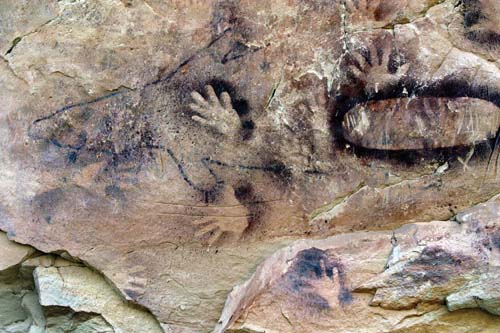
Aboriginal artists also paint figures and geometric patterns on sheets of tree bark, using natural pigments, such as ocher (an earthy mixture containing clay and iron oxide), clay, and charcoal. After European settlement, bark paintings became the most widely collected form of Aboriginal art.
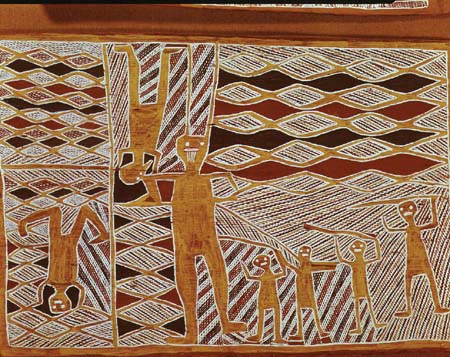
European settlement seriously interrupted the traditional culture of Aboriginal Australia and, in many areas, destroyed it. Today, Aboriginal artists practice traditional art forms mainly in the central and northernmost part of Australia.
In the late 1930’s, a group of Aboriginal artists living at Hermannsburg in central Australia developed a personal style of landscape painting in water colors. The most famous of these artists was Albert Namatjira. Namatjira painted water-color scenes of the dry interior of the continent. Namatjira’s paintings became especially popular among visitors to outback Australia, who bought many of his original works and reproductions of them.
Since the 1970’s, Aboriginal artists from communities across Australia have used a wide range of mediums, especially acrylic on canvas. In the early 1970’s, a group of artists in Papunya in the Northern Territory began to depict their religious rituals and ancestral stories on canvas. The works of Papunya artists such as Clifford Possum Tjapaltjarri and Michael Nelson Tjakamrra and Emily Kngwarreye from Utopia in the Northern Territory are now recognized as contributing to a highly original world art movement.
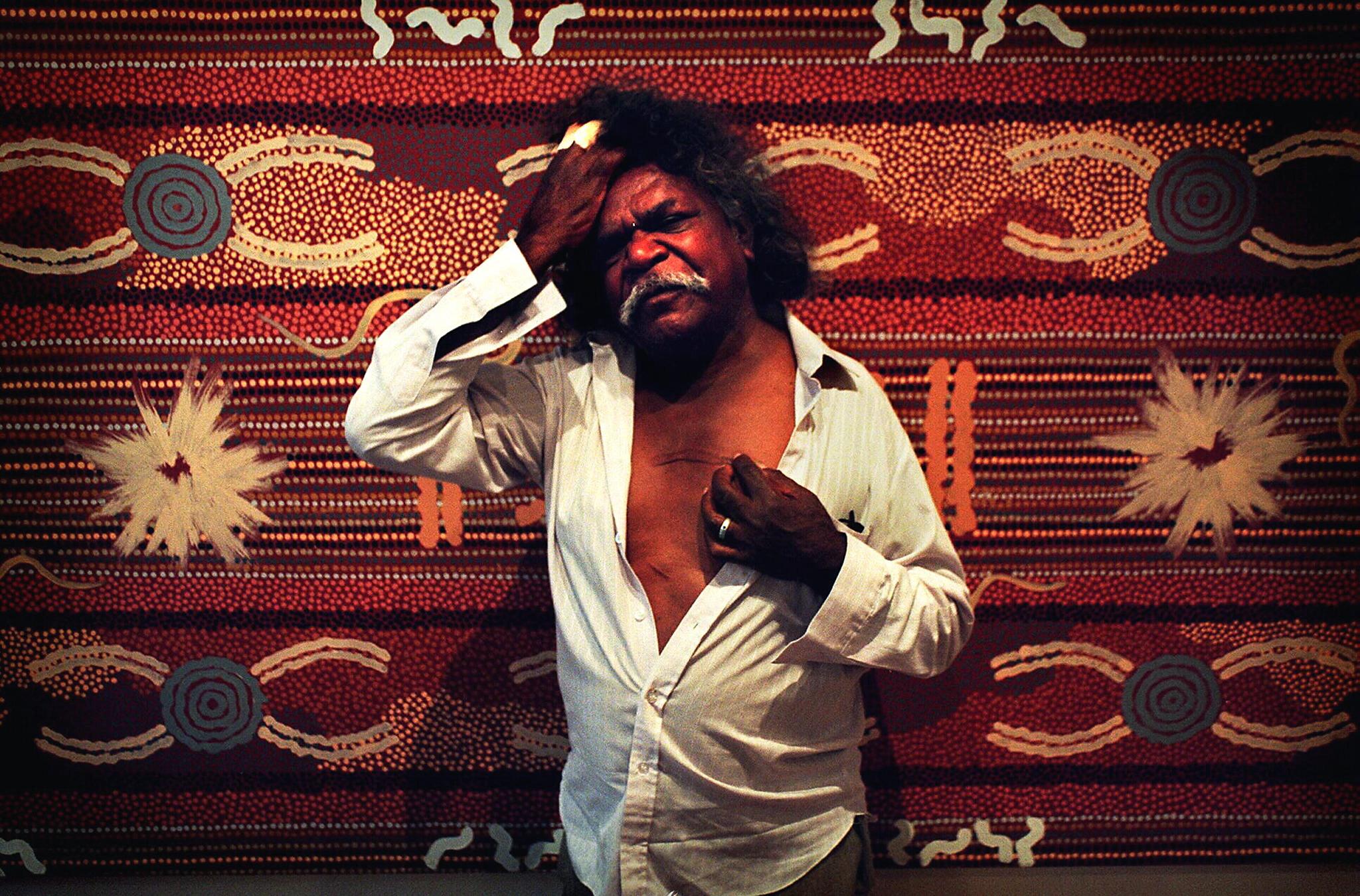
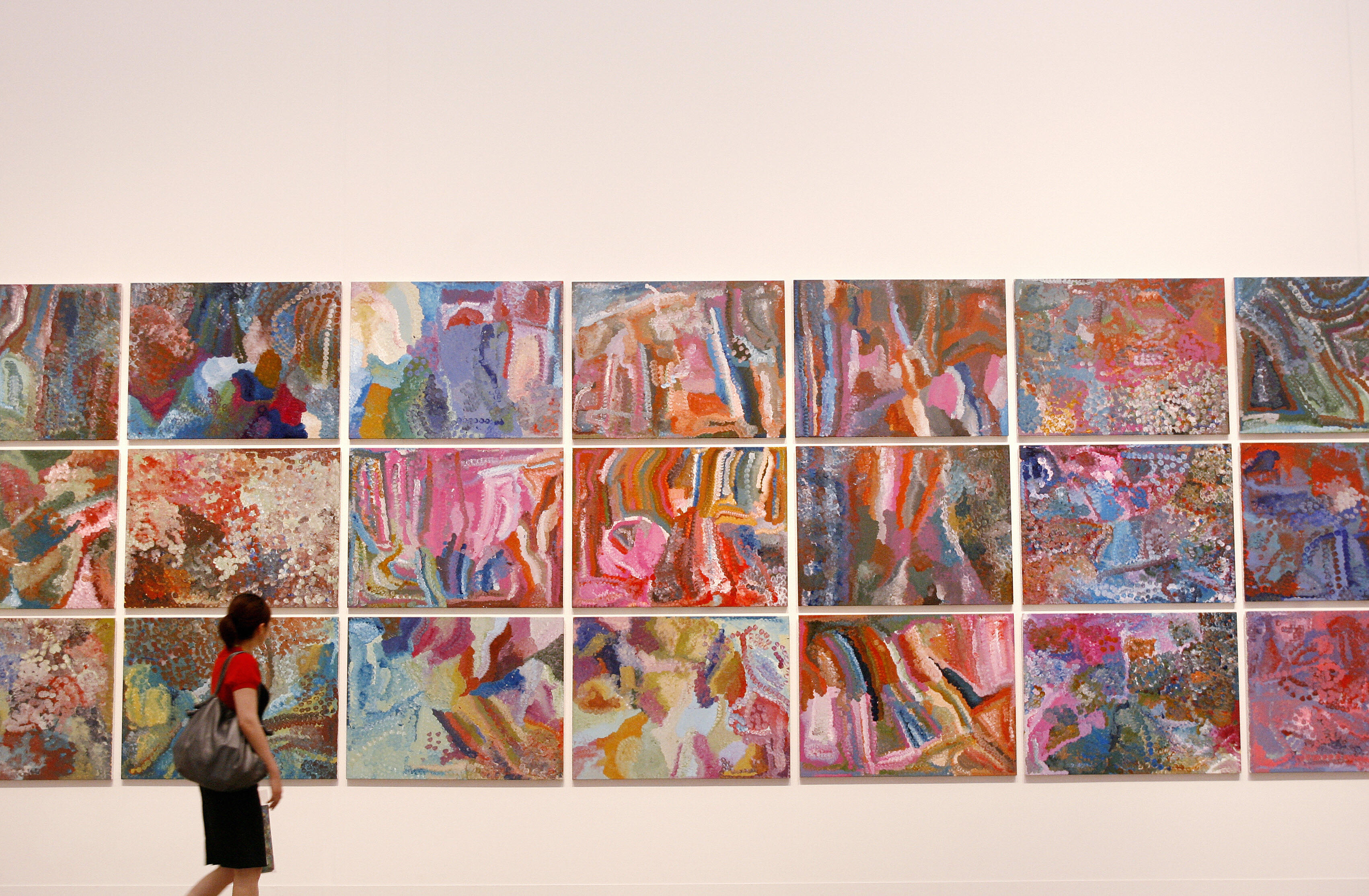
Australian painting and sculpture
Early colonial art
in Australia was produced largely by painters who recorded scientific and geographical information. Professional artists on voyages of discovery from Britain recorded the coastlines and harbors, plants and animals, and local people of the new British colonies for official reports.
William Westall, a British painter, accompanied the explorer Matthew Flinders from 1801 to 1803 as a topographical artist, whose job it was to make an accurate and detailed drawing of the surface features of the land. Westall sketched the Australian coastline and scenery as well as the Aboriginal people and their rock art. He later used many of his sketches to execute oil paintings and water colors for exhibition in London.
Many convicts who had been transported to Australia had some artistic training and were put to work as artists by the colonial administration. The Scottish-born Thomas Watling arrived in Australia in 1792, after he was convicted of forgery. Watling became one of the earliest convict artists to work in Sydney. He complained about the barren landscape and what he called the “little varied” plainness of the countryside.
Most of the early Australian painters were amateur artists. These included men and women who kept sketchbooks and painted water colors. Early professional artists also provided colonists in Australia with portraits and landscape views to send to Britain. Augustus Earle, who spent the years from 1825 to 1828 in Australia, was one of the most proficient of these artists. He painted portraits of leading colonists, but his principal interest was in producing illustrated books, including prints of the remarkable landscapes and people encountered on his journeys.
Many artists in the first decades of the 1800’s produced sketches of Australia for illustrated travel books published in London and Paris. The European market was eager for knowledge of newly explored and settled parts of the world.
Many successful colonial artists specialized in landscape painting. John Glover settled in Van Diemen’s Land (now Tasmania) in 1831 at the age of 64 after a successful artistic career in Britain. Glover painted idealized scenes of northern Tasmania. Conrad Martens was a topographical artist with the British naturalist Charles Darwin on the scientific expedition of the H.M.S. Beagle in the early 1830’s. Martens settled in Sydney in 1835 and painted stirring views of Sydney and its harbor. The Austrian-born painter Eugene von Guerard originally came to Australia in the gold rush of 1852. He recorded finely observed views of the Australian wilderness in a Romantic style. Louis Buvelot, a Swiss-born artist who settled in Melbourne in 1865, painted peaceful rural landscape scenes set in soft sunlight. Buvelot worked in a style that brought a new emotion and lyricism to Australian landscape painting.
A few colonial artists recorded events of their day. The English-born painter William Strutt, who immigrated to Australia in 1850, painted Black Thursday, February 6th, 1851 (1864), a scene of bushfires that swept through Victoria in 1851. The English-born sculptor Charles Summers created Australia’s grandest public sculpture of the 1800’s, a large bronze monument in Melbourne (1865) to honor the explorers Robert O’Hara Burke and William John Wills.
The later 1800’s.
The 1870’s through the 1890’s were decades of greater self-confidence among Australian artists. During this period, artists formed societies to exhibit their work, art teaching became fully professional, and art criticism developed. A number of high-quality illustrated publications, most notably The Bulletin, founded in Sydney in 1880, provided ongoing employment and solid training for artists.
A group of artists who painted in an Impressionist style, which tries to capture an immediate impression of an object or event, came together in middle and late 1800’s. They are often referred to as the Heidelberg School, after Heidelberg, a suburban village near Melbourne where they worked beginning in 1888. The main members of the Heidelberg School were Charles Conder, Frederick McCubbin, Tom Roberts, and Arthur Streeton. The Heidelberg artists focused on the Australian landscape and have since been acclaimed as pioneers of a distinctively Australian art. In their plein-air (open air) paintings, they tried to capture the momentary effects of color, light, and atmosphere. In 1889, the group held an exhibition of small landscape sketches called the 9 x 5 Impression Exhibition.
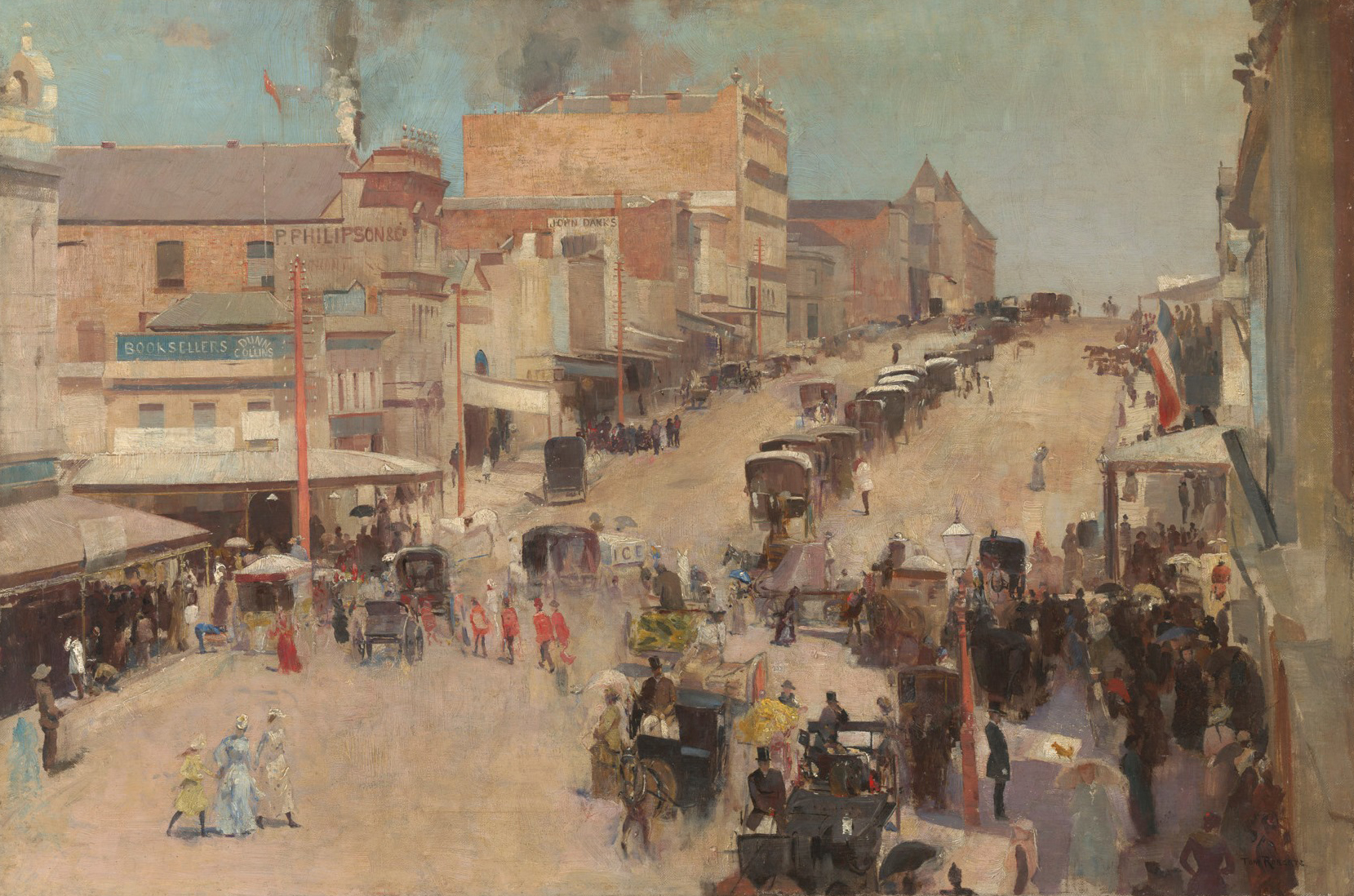
The early 1900’s.
Hans Heysen continued the nationalistic focus of the Heidelberg artists in the early 1900’s, depicting the nobility and grandeur of Australia’s remote countryside, which Australians call the bush. His images of towering gum (eucalyptus) trees seem to celebrate the ancient Australian land.
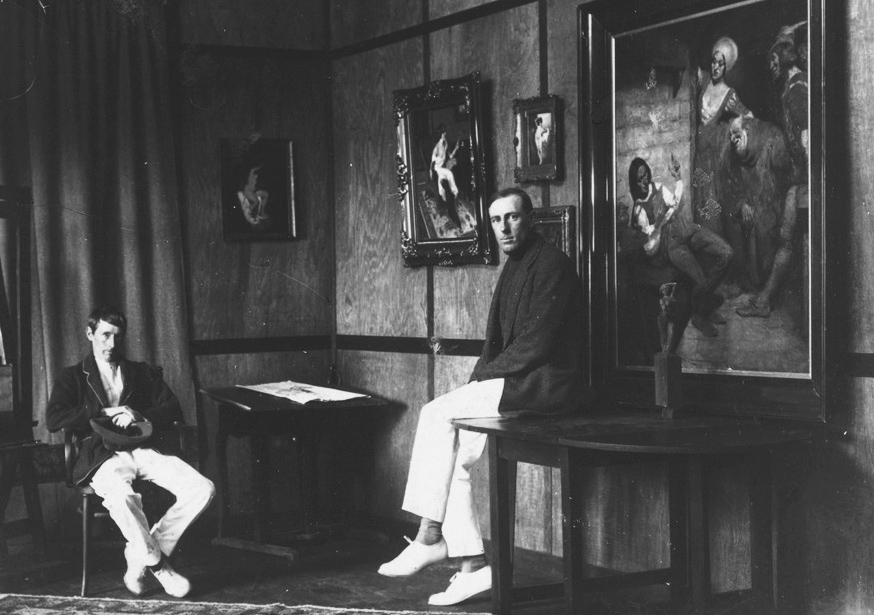
After initially studying in Australia, many artists left for Europe. The earliest Australian-born artists to study overseas were Robert Dowling and Adelaide Ironside in the mid-1800’s. By the early 1900’s, the number of artists who left Australia to study in Europe grew tremendously. Artists who studied and worked overseas included the painters Rupert Bunny, David Davies, E. Phillips Fox, Thea Proctor, Hugh Ramsay, John Russell, and Walter Withers, and the painter and sculptor George Washington Lambert.
Bertram Mackennal became the first Australian sculptor to achieve substantial recognition in London, with his graceful bronze figures in the early 1900’s. The British-born sculptor Rayner Hoff created sleek classical sculptures from the mid-1920’s through the 1930’s. The Anzac Memorial (1934) in Sydney incorporates many sculptures by Hoff.
In the early 1900’s, the artist and teacher Max Meldrum influenced a generation of Australian students. He claimed that his tonal style of painting was based on scientific principles. His own style reflected the influence of the Old Masters, the great painters who lived before the 1700’s, especially the Dutch painter Rembrandt and the Spanish painter Diego Velazquez.
With the 1920’s came the first wave of Modernist art in Australia. Modernist artists began to explore abstraction, a style that emphasizes shapes, colors, and patterns instead of recognizable subject matter. Artists who used Modernist ideas in their work included Roland Wakelin, Grace Cossington Smith, and Roy de Maistre in Sydney; and George Bell and Arnold Shore in Melbourne. In 1932, Bell and Shore opened an art school in Melbourne. Their students included Russell Drysdale and Sali Herman.
The Modernist printmaker and painter Margaret Preston sought to achieve a distinctive Australian art. Preston took a strong interest in Aboriginal art, which she thought the Europeans in Australia had largely ignored. She incorporated native Australian plants into her still lifes, and Aboriginal designs into her landscape paintings.
The mid-1900’s.
Throughout the mid-1900’s, Australian artists continued to interpret their country’s landscape and ways of life. Russell Drysdale, who was born in England and came to Australia as a child, painted the stark, eroded deserts of the Australian outback.
Sidney Nolan and Arthur Boyd were both influenced by the Heidelberg artists and became successful in London. In the 1940’s, Nolan painted a well-known series of scenes from the life of Ned Kelly, an Australian outlaw of the 1870’s who became a popular figure in the country‘s folklore. Boyd transposed Bible stories and themes from classical mythology to Australian landscape settings. 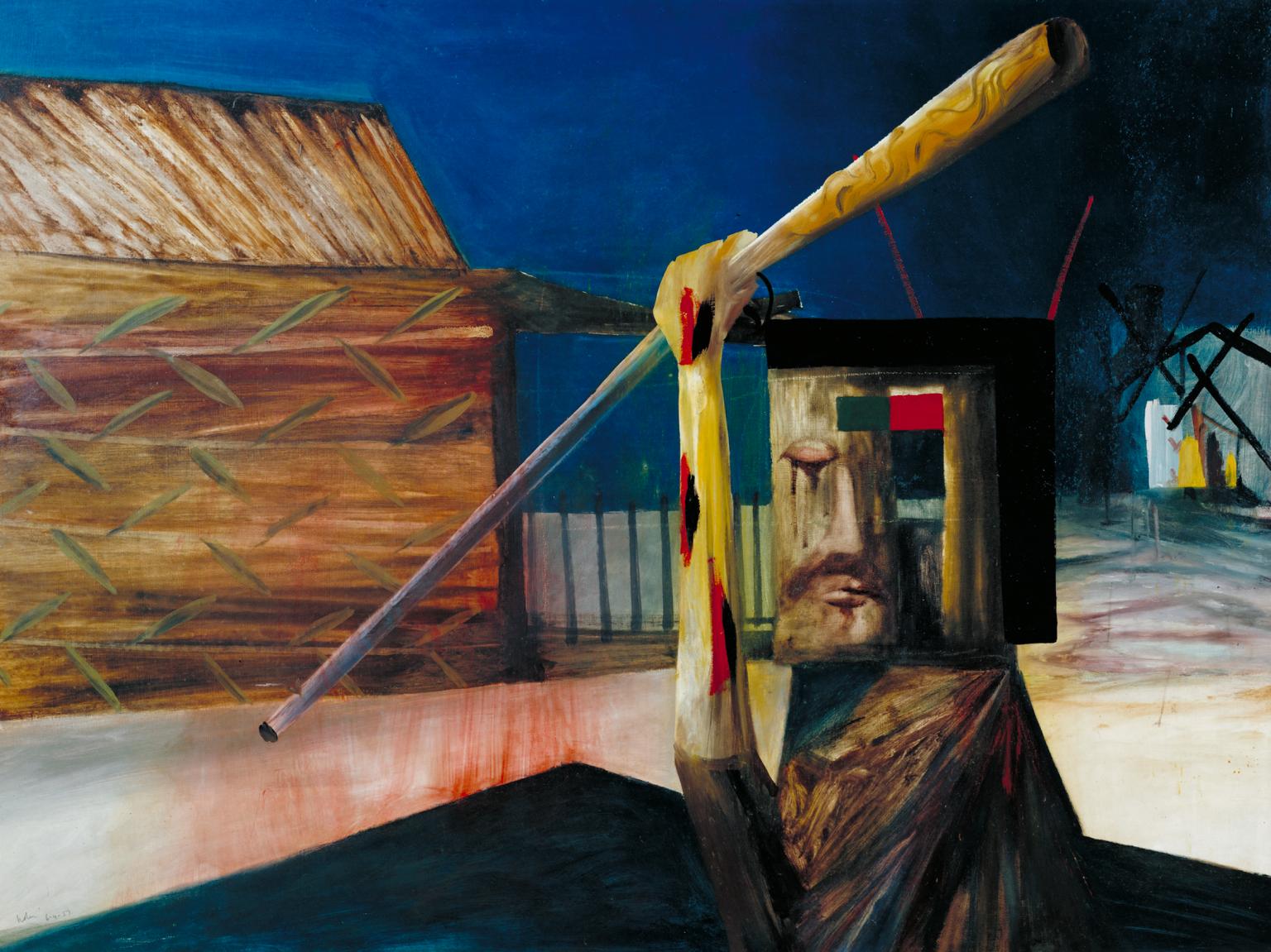
Nolan and Boyd were part of a generation of Australian artists who were determinedly Modernist. Others included Joy Hester, John Perceval, and Albert Tucker. Their work was inspired by the example of two immigrant artists, the Austrian-born painter Yosl Bergner and the Russian-born painter and sculptor Danila Vassilieff. This generation has become known as The Angry Penguins, named for the Australian avant-garde (experimental) periodical (1941-1946) of that title. The Angry Penguins used Australian subject matter in their work less for nationalist purposes than to express their own personal visions of Australia.
William Dobell produced figure studies and individual portraits during the 1930’s and 1940’s. Dobell painted in a generally realistic style but used subtle distortions to reveal the subject’s character.
Lyndon Dadswell pioneered Modernist sculpture in Australia. The abstract aluminum pieces that he created for the exterior of the Commonwealth Bank (1954) in Sydney were some of the first Modernist sculptures in Australia.
In the late 1940’s and 1950’s, the leading artists in Sydney followed a different path from those in Melbourne. Many Sydney artists, including John Olsen, became interested in Abstract Expressionism. Abstract Expressionism was an art movement concerned with painting as an act of free expression and with the use of expanses of related colors (see Painting (Abstract Expressionism)).
Many artists in Melbourne, on the other hand, distrusted the abstract style. In 1959, seven Melbourne artists and an art historian came together to form a group called the Antipodeans. The Antipodeans urged artists to reject abstraction and to preserve figurative art, which depicts human figures and other recognizable subjects. The Antipodeans were the painters Charles Blackman, Arthur Boyd, John Brack, Robert Dickerson, John Perceval, and Clifton Pugh; the sculptor David Boyd; and the art historian Bernard Smith. Brack, who later repudiated an association with the agenda of the Antipodeans, painted city and suburban life and everyday activities in a detached, ironic style.
Landscape continued as a major theme in the 1960’s, with John Olsen and Fred Williams creating abstract views of Australia. These artists interpreted the unique qualities of the Australian landscape in highly personal ways. The paintings of the Scottish-born artist Ian Fairweather featured a linear style that showed his interest in Chinese calligraphy (the art of fine handwriting).
Several abstract sculptors also created significant bodies of work in the second half of the 1900’s. They included Clement Meadmore, Inge King, and Robert Klippel. King, a German-born sculptor, designed several large outdoor sculptures in black-coated welded steel. Klippel created many pieces from discarded machinery parts and junk metal.
Beginning in the 1960’s, Abstract Expressionism coexisted with such movements as Pop Art, which took its themes and techniques from comic strips, advertising, and other types of commercial art; and Op Art, which employed optical illusions and unusual visual effects (see Painting (Pop Art)). An important development in abstract painting in Australia was a landmark 1968 art exhibition called The Field. The exhibition marked the reopening of the National Gallery of Victoria in a new building in Melbourne. It featured a group of artists, including Dick Watkins, whose aims included the reduction of painting to areas of pure color on a flat plane. These artists became known as color-field painters.
The late 1900’s and the 2000’s.
The Sydney artist Brett Whiteley gained attention with his expressive human and animal figures and abstract city scenes in the 1970’s and 1980’s. Whiteley painted in a style of his own, using vivid colors and emphasizing strong emotional content.
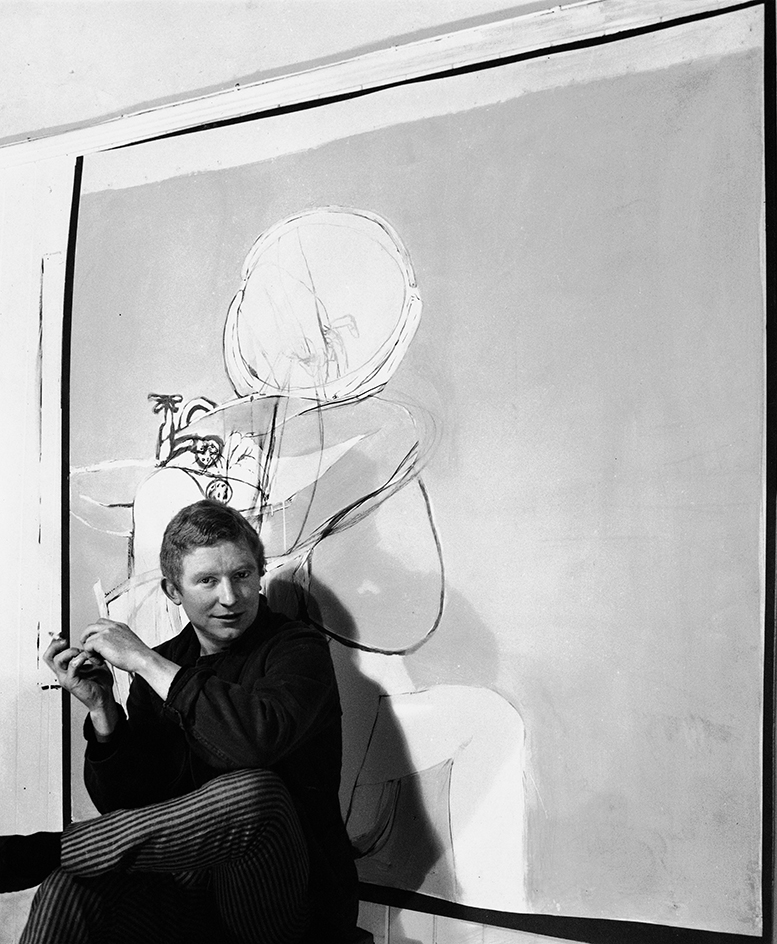
Aboriginal artists began to gain greater recognition from the 1970’s onward. Painters such as Rover Thomas and Dorothy Napangardi explored traditional techniques, such as the use of dots and other geometric shapes, in innovative ways. Thomas created paintings intended as abstract representations of recent Aboriginal history. Other themes explored by recent Aboriginal artists have included the Australian landscape, Aboriginal spirituality, and the tensions between Aboriginal and European Australian worldviews.
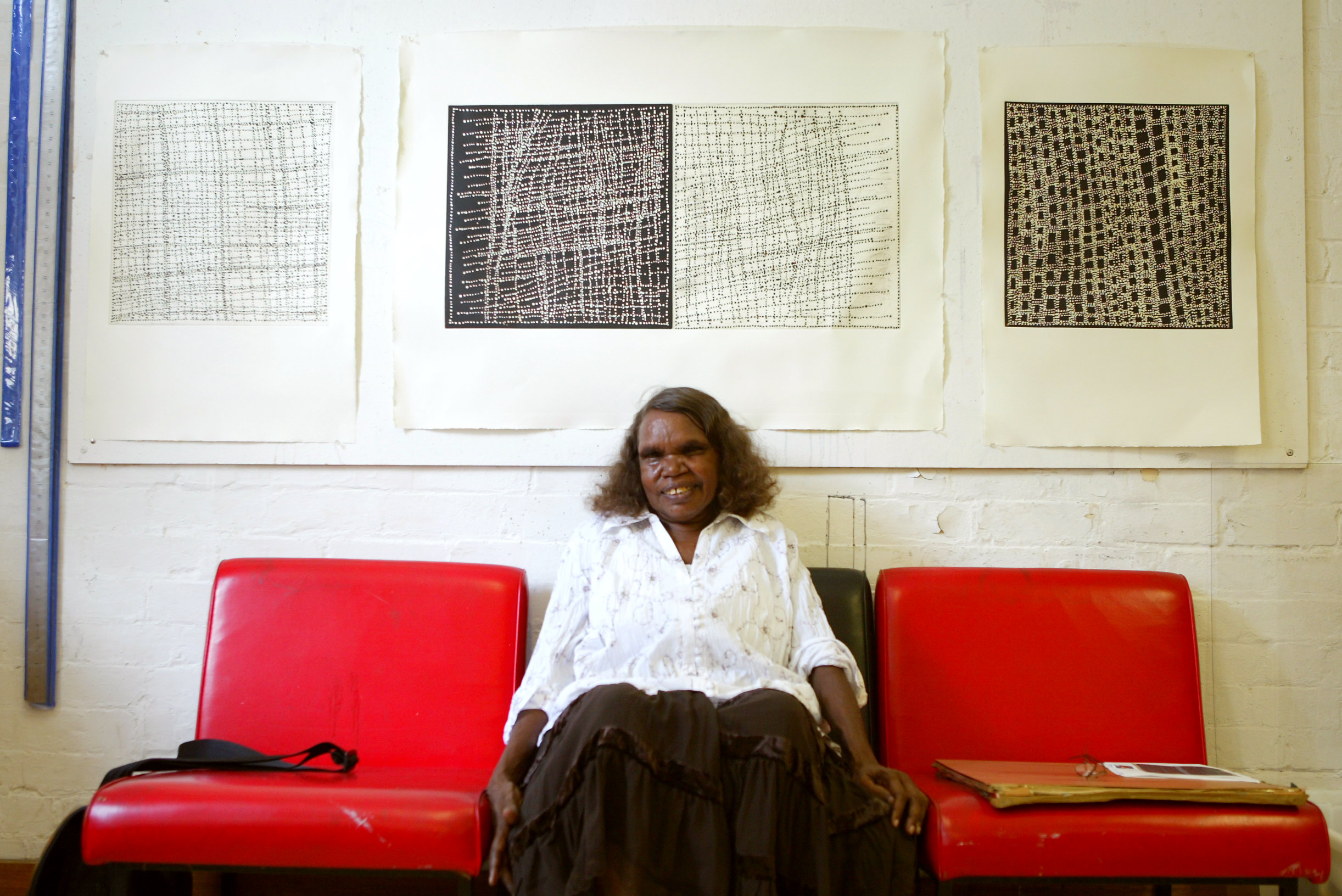
Sculpture and photography by Australian artists have continued to thrive in recent decades. Ron Mueck creates highly realistic and detailed sculptures of the human body on both large and small scales, through which he explores people’s unspoken feelings and private moments. Fiona Hall’s work includes photography, sculpture, and mixed-media creations, which often reveal the hidden beauty of everyday objects and experiences. David Noonan combines photos and stills from motion pictures to create unexpectedly eerie collages.
Australian artists in the 1980’s began to show an interest in cultural artificiality as a subject for their art. This interest is characteristic of the art movement called Postmodernism, which has continued into the 2000’s. Postmodern artists often make traditional styles their subjects and employ a blend of borrowed styles called pastiche. One of the most prominent Australian Postmodern artists is Imants Tillers. He combines images from European, American, and Aboriginal art, borrowing from the works of numerous painters.
Australian architecture
The architecture of Australia reflects the influences that have shaped the country throughout its history. England provided the main cultural influence until about 1900. After that, Australia was increasingly influenced by North America and Europe. Ideas and technology took time to travel across the oceans to the major centers of Sydney and Melbourne. Architectural styles and techniques tended to lag, especially during the colonial period.
Early architecture.
The first Australian settlers brought with them few architectural skills or building materials. Their buildings were similar to those of their homeland, modified by local conditions of climate, materials, and available skills. The first Australian buildings were simple boxlike structures, built of local materials. Most of them consisted of a timber frame filled with sticks and mud. Bricks, if used, were soft and set in mud mortar. Many of these poorly built structures decayed quickly.
For the first 50 years, Australian architecture developed within the framework of Georgian design, then the dominant style of architecture in England. Georgian architecture emphasized simplicity, symmetry, and classical details. Many of the first buildings erected in the new Australian colonies displayed the attractive proportions and restrained decoration of the Georgian style. Long porches called verandas were a popular feature. See Georgian architecture.
Francis Greenway was one of the first trained architects to arrive in Australia. Greenway had practiced architecture in Bristol, England. Later convicted of forgery, he was transported to Sydney as a convict, arriving there in 1814. Lachlan Macquarie, the governor of New South Wales, encouraged him to use his skills. During the brief time that he worked, from 1816 to 1822, Greenway created a number of fine buildings in the late Georgian style. Greenway designed well-proportioned buildings of reddish brick with tall, arched windows. Among his best works are the Hyde Park Barracks in Sydney (1819) and St. Matthew’s Church at Windsor (1821). 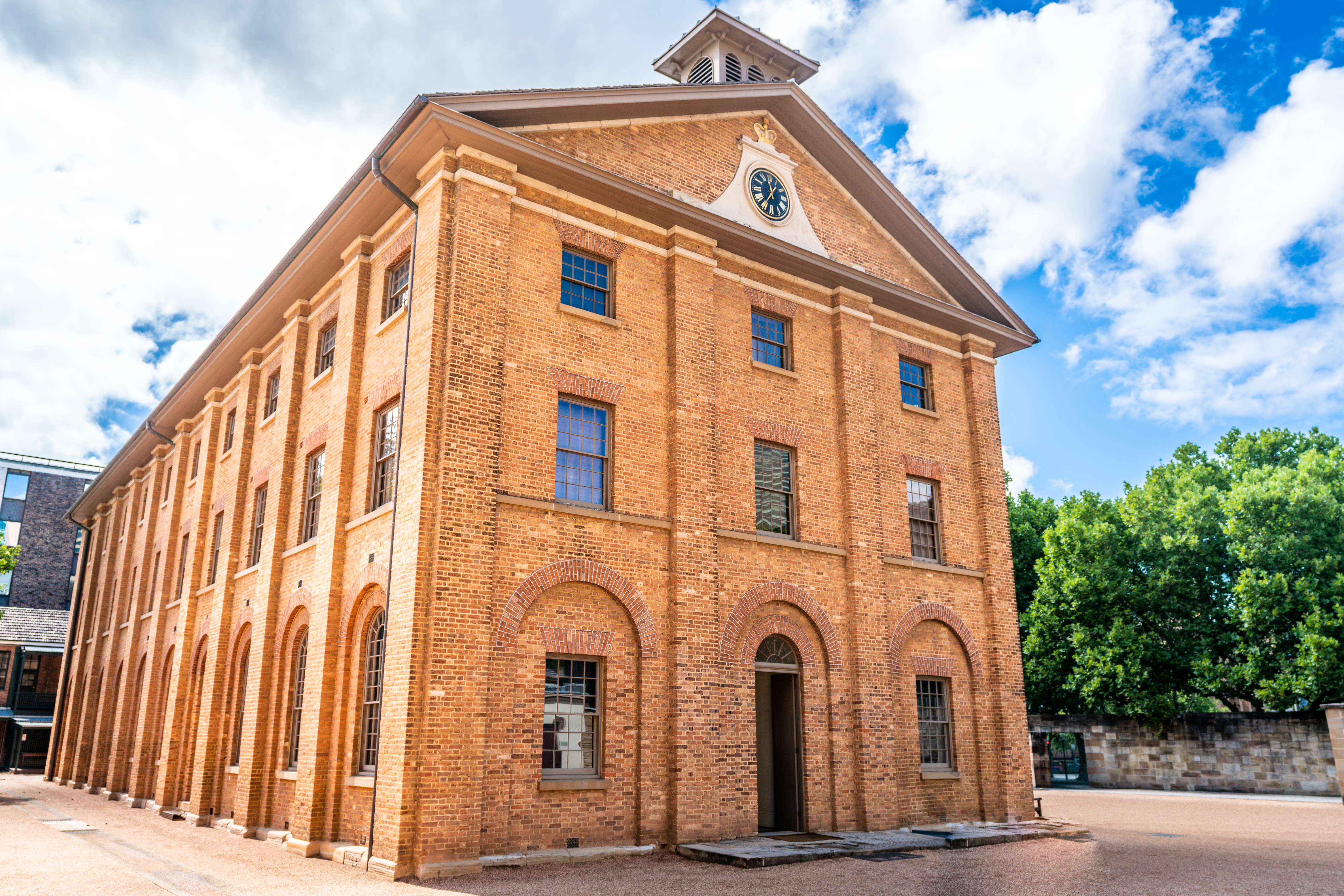
Australian architecture thrived during the 1830’s. A boom in wool products had brought prosperity to the colonies. The emergence of established and wealthy families and a rapid increase in the number of free settlers, including architects, led to the building of large, gracious homes. The prevailing architecture was a late variation of the Georgian style, known as Colonial Regency. Its proportions were on a grander scale than those of the earlier Georgian buildings. Exposed brick gave way to smoothly plastered walls, marked and colored to imitate stone. Low walls called parapets hid most of the roof. John Verge, who popularized the Regency style, created many large stucco houses in Sydney in the 1830’s.
Victorian architecture
takes its name from the reign of Queen Victoria from 1837 to 1901. New materials and methods brought about by the Industrial Revolution, a period of rapid industrial growth and new inventions, began to affect Australian architecture in the 1840’s. Architects substituted cast iron for timber for veranda posts, fire grates, and staircases. Galvanized iron roofing replaced shingles or lead or slate roofing on all but the most expensive buildings. The glass industry developed a new technique of blowing glass that produced larger sheets. Bigger windows began to replace the small Georgian panes.
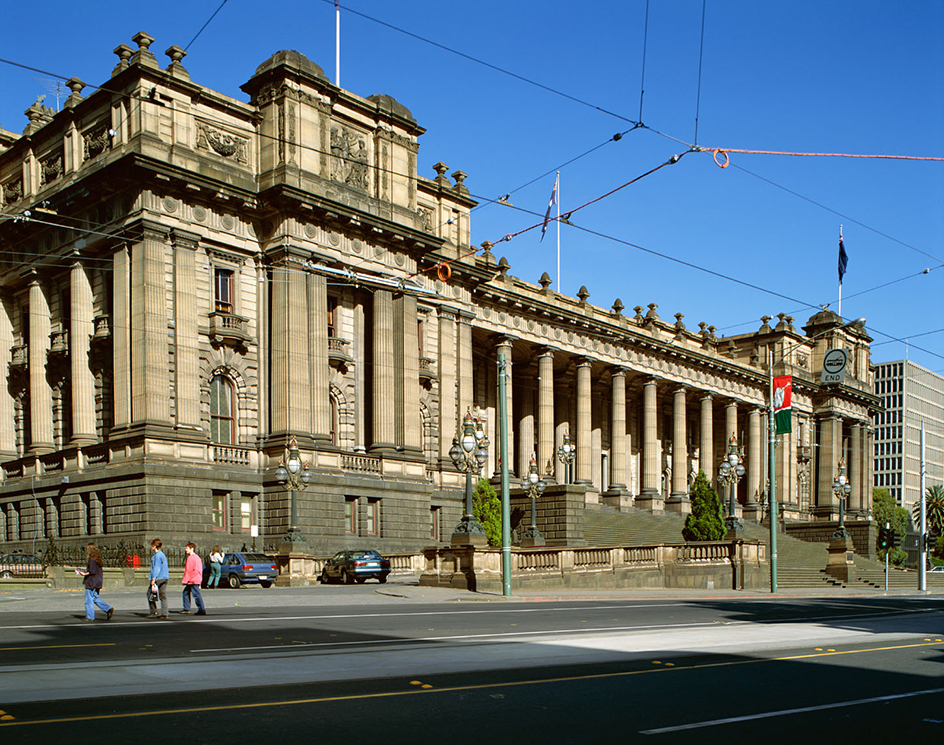
At the same time, many architects revived various styles of the past. The most important revivals were the Greek Revival and the Gothic Revival. Mortimer Lewis helped popularize the Greek Revival style, derived from ancient Greek temples and public buildings. Lewis designed a Greek Revival courthouse with huge, dignified columns at Darlinghurst, in Sydney. In 1842, the English-born architect Edmund Blacket arrived in Sydney. During his term as architect of the Anglican Church diocese of Sydney, he designed religious buildings of stone in the Gothic Revival style. The Gothic Revival style featured tall, graceful buildings with pointed arches and large stained-glass windows. It became the established style for churches for the next 100 years.
The discovery of gold in the early 1850’s introduced many changes to Australian society that were reflected in the country’s architecture. New tastes and a demand for new types of buildings emerged from wealthy clients, new immigrants, and the rise of commerce. During this time, the open towns of the 1800’s developed into crowded modern cities and sprawling suburbs.
During the Victorian era, architecture became increasingly showy. In the 1850’s, buildings were generally drab, made of cheap materials, and fairly simple. During the next 30 years, they became steadily more decorated. Architects dressed their buildings in adaptations of Gothic, Egyptian, Chinese, Roman, Greek, Venetian, or Italianate style. Often, they combined two or more styles.
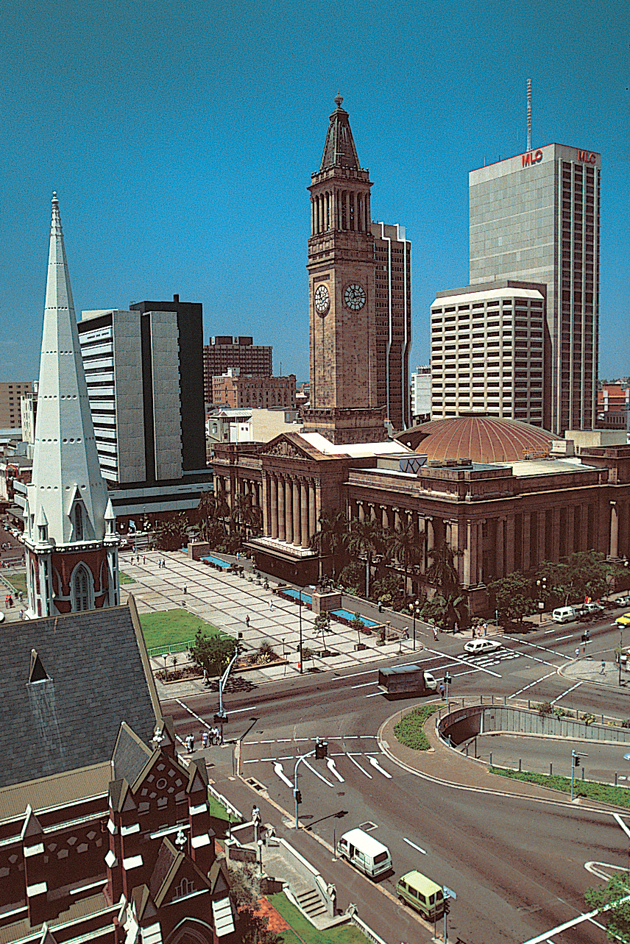
From 1855 until 1885, when the gold fever began to subside, the wave of prosperity encouraged more and more building. Many buildings carried mass-produced plaster decorations, such as shells, vases, garlands, scrolls, and bunches of grapes. Also popular were columns, decorative towers and domes, statues, gold leaf, mosaics, and cut crystal.
In the 1880’s, passenger elevators were first installed in Australian city buildings. As a result, buildings could be much taller. In the same period, electric lighting began to replace the gas lighting used since the late 1830’s.
Federation architecture
flourished during the reign of King Edward VII in the United Kingdom, which lasted from 1901 to 1910. A new kind of architectural style had begun to appear during the 1890’s. Compared with the Victorian style, it was simple and plain. Applied ornament of plaster, marble, brass, and glass had lost favor. This new architecture came to be known as the Federation style.
Federation buildings in Australia were squat, boxlike forms constructed of red brick and terra cotta, with creamy trim. Flat terra cotta panels replaced the decorative flat moldings. Large semicircular arches, sometimes surrounding heavily framed square windows, punctured many walls. These innovations derived from work of the American architect Henry Hobson Richardson in Chicago in the late 1880’s. They show the growing influence of the United States on Australian architecture.
Modern architecture.
Early in the 1900’s, architects worked with new materials. John Monash, a young engineer and architect, later a military leader in World War I (1914-1918), pioneered the use of reinforced concrete, made by casting concrete around steel rods or bars for added strength. The war created a large-scale steel industry in Australia. That led to rolled steel beams, columns, and reinforcement materials, which were inexpensive and easily available for the first time. Tall steel-frame buildings constructed of reinforced concrete appeared during the early 1920’s. 
Australia’s architecture in the early and middle 1900’s borrowed from earlier work done in Europe and the United States. New buildings in the Modern style—clean, functional, rectangular, and free of decoration—began to appear in the late 1920’s. These buildings were characterized by horizontal elements with vertical counterpoints and accents. An architecture style called Art Deco, imported from the United States and Europe in the 1930’s, featured shiny black surfaces, chrome strips, sharp geometric lines, and broken circles.
After World War II (1939-1945), Australian architecture went through a 10-year period of austerity. Shortages of materials, labor, and money limited new building and housing. The architectural tempo picked up again in the prosperous mid-1950’s. New large industries started up. Private businesses developed vast financial resources. Governments became increasingly active in education, health research, and many other areas. These changes led to the building of many factories, universities, hospitals, and civic buildings.
New buildings from this time were largely American-inspired. Many architects designed severe boxlike buildings. The buildings consisted of a metal frame covered by curtain walls of glass, plastic, or metal sheets, which provided no support but hung like curtains on the frame. Bare concrete became a popular building material. One of the most distinguished buildings from this period is Australia Square (1967) in Sydney, a reinforced concrete design by the Austrian-born architect Harry Seidler. The Olympic Games held in Melbourne in 1956 produced an outstanding swimming pool building, designed by John and Phyllis Murphy, Kevin Borland, and Peter McIntyre. The Sydney Opera House designed by the Danish architect Jorn Utzon in 1957 drew Australian architecture to the attention of the world when it was completed in 1973. Its innovative design, with towering white shells that resemble billowing sails, made the structure perhaps Australia’s most familiar modern landmark. 
The Sydney-based architect Philip Cox designed the Yulara tourist village (1984), a visitors resort at Uluru (also called Ayers Rock); the Sydney Exhibition Centre (1988); and a number of notable sports structures. Beginning in the 1990’s, Daryl Jackson gained recognition for his high-rise office buildings and other structures in Melbourne. Another Melbourne-based architect, Cassandra Fahey, became known for the diversity of her work. She has designed houses and public structures in a wide variety of styles, rather than developing a common theme.
In the late 1900’s and early 2000’s, some architects drew inspiration from the buildings of Australia’s countryside, especially farmhouses and outbuildings such as woolsheds, where sheep are sheared and their wool processed and stored. Among those architects was Glenn Murcutt. In 2002, he became the first Australian to win the Pritzker Architecture Prize, often considered the “Nobel Prize” of architecture. Murcutt builds only in Australia and designs his buildings to fit the landscape and climate. His structures make extensive use of corrugated iron sheeting and other rural building materials.
Other architects in recent decades have been inspired in various ways by the natural environment and climate of Australia. Richard Leplastrier has designed naturalistic wooden houses that are intended to show respect for the environments they stand in. Sustainability, or taking care not to use up resources or harm the environment, has been important in recent Australian architecture. Council House 2, completed in 2006 and home to Melbourne’s city council, became the first building to receive the highest sustainability rating from the Green Building Council of Australia.
Australian decorative arts
Until about 1900, designers in Australia followed European styles, often adding Australian motifs to their work. During the Arts and Crafts movement of the early 1900’s, however, some designers began to develop distinctively Australian styles.
Significant metalwork first appeared in Australia in the mid-1900’s. At that time, Helge Larsen, a Danish immigrant, and Stuart Devlin, a Melbourne industrial designer, produced excellent silverwork. Devlin also designed Australia’s decimal coins.
In the early 1900’s, Merric Boyd became Australia’s first important studio potter. The painter John Perceval started another career in the mid-1950’s making ceramics. His pottery shows imaginative modeling of figures. During the early 1960’s, a few potters, such as Col Levy, turned for inspiration to Asian pottery. A Postmodern style in ceramics began to emerge in the 1980’s, often reflecting archaeological influences as well as inspiration from many cultures.
In 1987, Bronwyn Bancroft, an Aboriginal fashion designer and painter, was among several Australian designers who displayed their work at the Au Printemps fashion show in Paris, France.

British furniture styles heavily influenced furniture design in Australia throughout its history. Furniture designers in Australia have made great use of native woods, especially red cedar.
